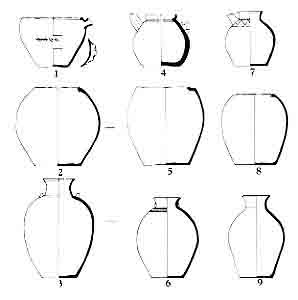Image Details

Drawings of Early Bronze II–III and MBI pottery. Archaeologists depict pottery in a way that shows many features that cannot normally be seen at one time. Each drawing is divided by a vertical line. To the left of the line we see the vessel drawn as it would appear if seen intact from the outside. To the right the vessel appears as if sliced in half vertically, parallel to the plane of the picture; this section view shows the varying thicknesses of the wall of the vessel. The composite of right and left views tells us a great deal about the shape, decoration and special features of the pottery.
Vessel number 1 has a ledge handle seen in its center crossing the vertical line; to the right of the vessel, this handle is depicted in a top view. This vessel is typical of the EBII–III period in the Negev. Vessel number 2 is a “hole-mouth” jug typical of the EBII and probably used in the EBIII period at sites in the central Negev. Similarities in form are evident between the EBII–III examples (1–3) and the latter MBI vessels (4–9)—a fact which leads the author to believe that the MBI people adapted some of the pottery forms of the EBII people whom they conquered and replaced at certain sites.
